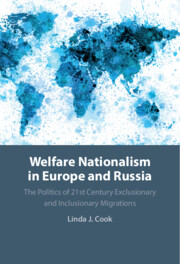 Welfare Nationalism in Europe and Russia
Welfare Nationalism in Europe and Russia Failed Solidarity, Successful Securitization
from Part III - Exclusionary Migrations
Published online by Cambridge University Press: 14 November 2024
Chapter 6 looks at political responses to the MENA migration to Europe from 2011, the most harshly exclusionary case in my study. The migration mixed asylum seekers fleeing wars in Syria, Iraq, and Afghanistan, with labor migrants from other MENA states. The chapter tracks Europe’s progression from initially cautious receptiveness of asylum seekers to policies of exclusion of MENA migrants from the continent. It shows that the growing numbers, migrant “mix,” and terrorist attacks by (mostly non-migrant) Islamic extremists in Europe combined to undermine need-based deservingness, empower populist parties and feed xenophobic media. The chapter focuses on the EU’s turn to militarized securitization of its land and sea borders and ‘externalization of borders’ to Turkey and Libya, policies that ended the migration surge by indiscriminate physical exclusion of migrants and asylum seekers. Case studies show the varied effects of and responses to the migration in the five European cases and in Russia, which received much smaller numbers. Responses to the MENA migration brought international migration to the core of Europe’s politics, entrenched populist parties, and showed the failure of the Geneva Convention asylum system in the 21st century.
To save this book to your Kindle, first ensure [email protected] is added to your Approved Personal Document E-mail List under your Personal Document Settings on the Manage Your Content and Devices page of your Amazon account. Then enter the ‘name’ part of your Kindle email address below. Find out more about saving to your Kindle.
Note you can select to save to either the @free.kindle.com or @kindle.com variations. ‘@free.kindle.com’ emails are free but can only be saved to your device when it is connected to wi-fi. ‘@kindle.com’ emails can be delivered even when you are not connected to wi-fi, but note that service fees apply.
Find out more about the Kindle Personal Document Service.
To save content items to your account, please confirm that you agree to abide by our usage policies. If this is the first time you use this feature, you will be asked to authorise Cambridge Core to connect with your account. Find out more about saving content to Dropbox.
To save content items to your account, please confirm that you agree to abide by our usage policies. If this is the first time you use this feature, you will be asked to authorise Cambridge Core to connect with your account. Find out more about saving content to Google Drive.